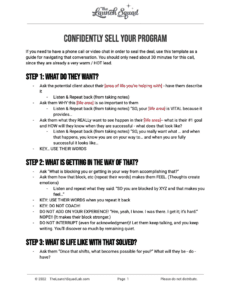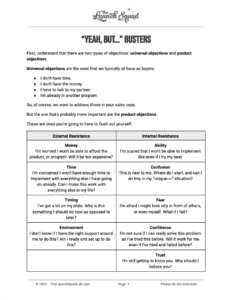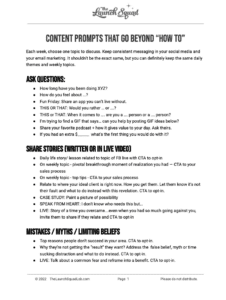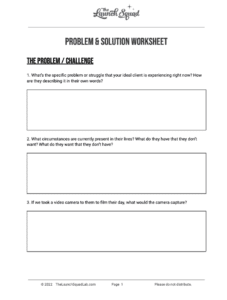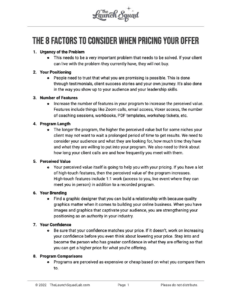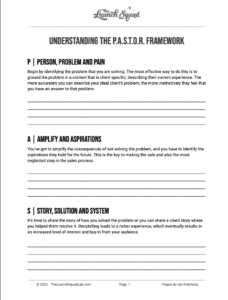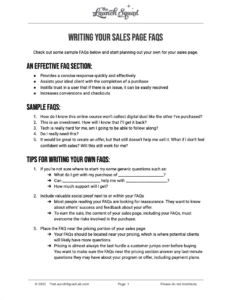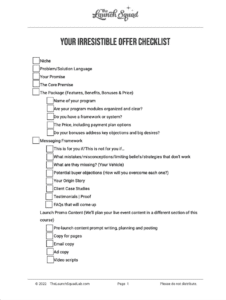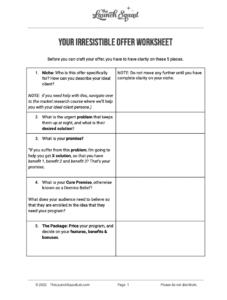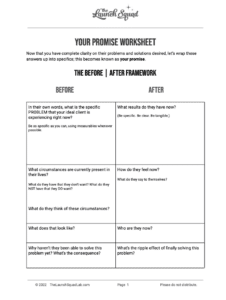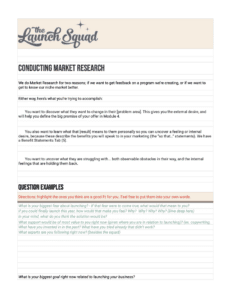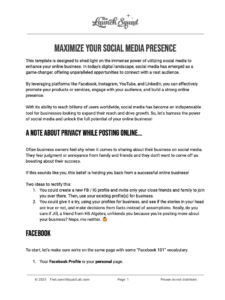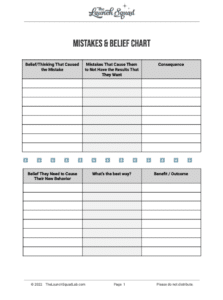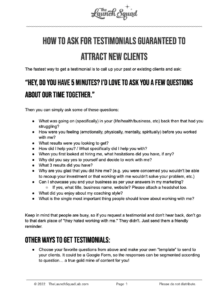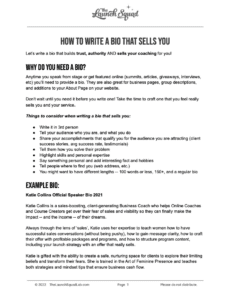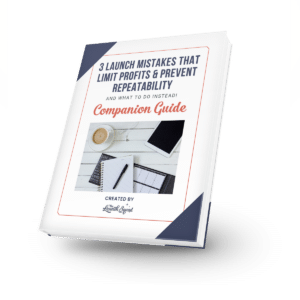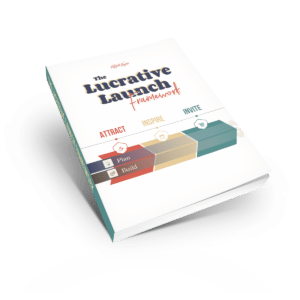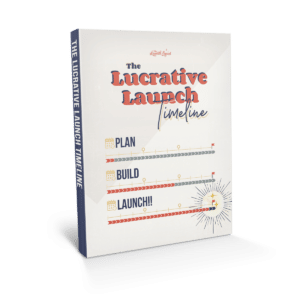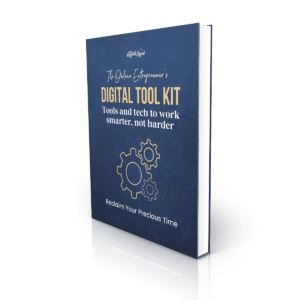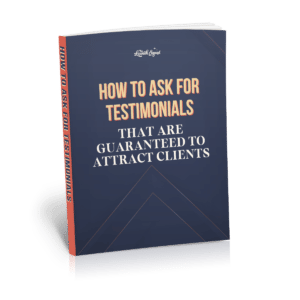Have you ever put your offer out there only to hear the vacant sound of crickets? We get it. We’ve been there too. But what do you do about it? Today we’re talking about how to really get your message out there so that it’s heard AND heard by people you actually want to work with.
Our guest today is a Business Impact Strategist and Kick Butt Speaker. She has her MBA and is a Certified Professional Co-Active Coach. Whether working one-on-one or with groups, she puts people into action with her strategic, results-oriented approach. She specializes in helping entrepreneurs with a mission and a message to get clear and design sustainable solutions to maximize their impact and income. She helps her clients redesign their business to help their ideal clients get amazing results, make room for a great life, have fun fulfilling their greater purpose, and make sustainable profits.
Connect with Amy Zastrow:
[00:00:00] Jeffrey: Welcome to the Lighten your launch podcast today, we're talking about the deafening roar of silence when you promote your offer and what to do about it. So stay tuned. Have you ever put your offer out there only to hear the vacant sound of crickets? We get it. We've been there too, but what do you do about.
[00:01:08] Jeffrey: Welcome to the show. I'm Jeffrey Samorano, I'm back again with Katie Collins today. We're talking about how to really get your message out there so that it's heard and heard by people who actually want to work with you.
And you wanna work with them. Katie, who are we talking to today?
[00:01:27] Katie: She is a business impact strategist and kick butt speaker. She has her MBA and is a certified professional co coach, whether working one on one or with groups, she puts people into action with her strategic results oriented approach. She specializes. In helping entrepreneurs with a mission and a message to get clear and design sustainable solutions to maximize their impact and their income.
She helps her clients redesign their business to help their ideal clients get amazing results. Make room free, great life, have fun, fulfilling their greater purpose and make sustainable profits. Welcome to the lightener launch podcast. Stage Amy CSRO.
[00:02:12] Amy: Hey, great to be here. So fun to play with
[00:02:15] Katie: Yeah, we're glad to have you here. So I, you know, we wanted to dive in today and really talking about the importance of having that clear target market and ideal client. So let's just start off with why is that so important? Because for those of you, you know, like life coaches out there that are like, I can help anybody with a life, we wanna kinda reign that in a little bit.
[00:02:42] Amy: Oh, my favorites. you start off with my favorites. Um, yeah. Having a clear target market, an ideal client. I mean, seriously, if you are saying I can work with anyone. um, here's what I got to say to you just because you can doesn't mean you should. So. If you don't wanna waste time or money or, you know, be unfulfilled, then get clear in your target market.
I mean, who are you aiming at? You wanna get the right clients that you can help better so that you get known in your industry for solving that problem. And. People will send referrals to you. People will be, oh, if those people work with them, I wanna work with them. And it just kind of grows from there. So if you're getting clear, then you can also make decisions easier about, you know, should I market on this new platform?
Should I, you know, invest in this program to get better at whatever it is. I think a lot of times we focus more on those things than. You know, does this help me serve the client I wanna serve or, Hey, I like to learn so you can make those decisions. Stop wasting money and help your clients get great results, which is more fun and more fulfilling.
Cuz you're operating from your own talents and gifts. Yeah.
[00:03:55] Katie: I'm so glad you said that. Um, we see that all the time. I know I've done it myself where, you know, oh, like something, isn't something in business isn't working. Where can I spend more money?
[00:04:08] Jeffrey: Katie does this all the time. Katie does this all the
[00:04:12] Amy: As a business partner, you
[00:04:13] Katie: Now, now that's not fair. Now I'm spending money on team.
[00:04:18] Amy: would know yeah,
[00:04:19] Katie: we're not buying programs. We're we're building team and that costs money, but it it's true. It's like, oh, you know, I'm gonna go ahead and just invest more in marketing, or I'm gonna invest more in social media support. Right. I'm gonna invest more in Facebook ads and we're really seeing the impact.
If you Don. Like get very clear on who you're talking to and what they want to hear you say, then throwing marketing dollars at it will not solve your problem.
[00:04:49] Amy: I just worked with someone who said, why aren't my Facebook marketing ads. I hired an expert. Why aren't they working? And so we went through and did her ideal client and she's like, you know, her ideal clients are not on Facebook. Her demographic that she's going at her target market is not on Facebook. I said, and we happen to be in a program together.
And I said, well, how did you get to this program? She's like, well, Instagram, I love Instagram and it's like, she responded to an ad on Instagram, not Facebook. Yes. They're owned by the same people. Yes. The demographics are also very different. So, um, you need
[00:05:21] Katie: yeah.
[00:05:22] Amy: to think about where are your ideal clients? What, you know, where can you reach them?
[00:05:27] Katie: Mm-hmm
[00:05:28] Amy: So, if you don't know who they know resonate, so it's like, you got both who they are and what problems they have that you can reach them with.
[00:05:36] Katie: Yeah.
[00:05:37] Amy: yeah. It's
[00:05:37] Katie: So on
[00:05:38] Amy: light bulb.
[00:05:39] Katie: on that same note, um, something I love about what you teach is, um, it's not just about like, The people and what they wanna hear from you, but it's about who you want to spend time working with.
[00:05:53] Jeffrey: yeah.
[00:05:54] Katie: right. Because it, we all know it can be very draining to have someone that you're working with.
That's either, you know, ungrateful or, uh, unwilling or uncoachable, right? Like all those things, it can get very draining very quickly. So I saw, um, Uh, I think on LinkedIn, you had posted a target market checklist and you had these four words. Do, do you recall what the four words are?
[00:06:17] Amy: of course I do.
[00:06:18] Katie: okay.
[00:06:19] Amy: yes.
[00:06:20] Katie: a little bit about those four words and why, why this matters when someone's choosing their target market.
[00:06:26] Amy: Yes. I, I call it a magnetic target market checklist because you wanna, you know, attract the right clients. So who are they? The first thing is, are they helpable, do they have problems that you can solve? Do you have the skills, knowledge, and ability to help them get what they want? The second thing is, are they reachable?
So. Trying to think there was, I saw in one group, you know, cuz of course we're all in different groups on social media. And so was it in one group? And she's like, oh, I wanna reach, you know, celebrities or something like that. And what, what kind of newsletter could I put together? I'm like, honey,
[00:07:00] Jeffrey: they're not reading
[00:07:01] Amy: if you don't know any celebrity news, you know, newsletter is not gonna reach them.
So, you know, you approach them differently based on. What is you offer what they need, what they use and consume and all that. So are they reachable on social media? Are they reachable via newsletter or is it the one-to-one contact referrals? I mean, there are different marketing and I think social media and email marketing is the easiest, right?
It's like, okay, I can write an email. I can, you know, post something on social media, but is your target market reachable that.
[00:07:37] Jeffrey: Yeah,
[00:07:37] Amy: they have a problem, do they actually reach out to the network? Hey, who can help me with,
[00:07:42] Jeffrey: right.
[00:07:43] Amy: they may do it via social media. For some, for some, they're just gonna call up someone they know who has solved that problem.
So are they reachable for you and are they lovable? I mean, I, we spend so much time at work. Do you love working with them? The more you love working with them, the more you're gonna wanna solve their problems and keep, you know, Learning and growing yourself in order to help them right. Reach that, whatever that next level is.
So are they lovable like, or did they, the phone rang and you go, oh, not them again. it's like, oh no. And then the last is, are they profitable? You know? And the easy example is a career coach. The unemployed needed a career coach, right. Especially if they've been unemployed for a long period of time, but because they're in a desperate mode have been unemployed, you know, no paycheck or just unemployment coming in, they don't have the funds to probably pay you.
So, you know, reserve one or two spots for them in your practice, but you know, who are the ones who are thinking about changing jobs and need to update their resume or practice their interview skills or, you know, update their LinkedIn or whatever that happens to be your specialty, but are they profitable?
Can you actually, is there enough of them to make a profit and, you know, are you charging fees that are, make it worth.
[00:09:08] Katie: I love that. So we've got helpable reachable,
[00:09:12] Amy: Lovable and profitable. Yes. And if you don't have those
[00:09:17] Jeffrey: Yeah, and that reachable one is tricky. And I've heard this, um, from clients before where they're trying to reach seven figure income executives or whatever. Right. And like literally the harder, like same with celebrities, right? The higher up, the more your audience values, their.
The harder it is to reach them. Right. Those people are not in their inbox. They're rarely on social media. They've got better things to do than to quite frankly, this sounds awful, but they've got better things to do than to listen to your pitch. Right.
[00:09:54] Amy: Yes.
[00:09:55] Jeffrey: So reaching those people much, much harder. So I, I love that you included that because it, that is really something to consider.
Right? What are, what, where are, where is your audience? Are they even reachable?
[00:10:09] Katie: yeah. By you. Right. Because
[00:10:12] Amy: exactly. Access to
[00:10:13] Katie: yeah. It's, you know, that's why people pay to play and join these higher end masterminds, cuz then they're around the same people that need to hire them. But if you're not doing that, um, launching, you know, they're gonna send their team to your launch.
They're not gonna attend your launch. Right.
[00:10:31] Amy: right.
[00:10:32] Katie: so, um, So we talk a lot about target market, ideal client, client avatar. I hear these words, you know, thrown around used interchangeably, um, to you. Are they the same or if not, what, what makes a distinction between them?
[00:10:51] Amy: well, I have a preference in what you call them. I do believe they're similar in some content, but I, I use ideal client and I have people create an ideal client profile or, or, you know, work that through with them. The reason being is you want it to be ideal, who is the best of the best, the ones that you absolutely love.
And they absolutely love you. And I use the word client really intentionally because I believe that customer is transactional and client is relational and relations. You, you know, if you have a relationship with someone it's longer term, it's not just this, you know, one and out kind of thing. So I intentionally use ideal client pro profile.
Personally, I don't like customer persona because of the word customer or buyer persona. That's okay. But you know, a persona is meaning they're not really real. They're not a real person to you. Um, and the fact that they're buying doesn't mean that they're ideal. or that it's even sustainable reachable, all those fun things.
The client avatar again, you know, the word client is great avatar to me. I don't know about you guys, but I think of video games and avatar, or that blue, that blue character, you know that the movie
[00:11:57] Katie: movie.
[00:11:58] Amy: yeah. Kind of cartoonish,
[00:12:00] Katie: always
[00:12:00] Amy: again, not real.
[00:12:02] Katie: when I hear that word now
[00:12:05] Amy: don't I mean, come on. So, I mean, yes, they can be similar, but. For me when I'm, I'm helping my clients, it's looking at who is their target market. So that's that group of people that they're targeting with their market, the demographic buffets, you know, per se. And then when you, if I actually draw a heart, if you're, if you have a pencil, draw a heart at the center, like at the bullseye, have a target.
And then the circle around that is your target market. This there's another circle around that, the potential market and. The reason. Why is that that ideal client is those people that you absolutely love and they absolutely love you. So if you are aiming in, on who that is, you actually need a person within that heart.
So that you can aim at a person when you're writing an email. It's it's like, okay, dear Katie. You know, if Katie is my ideal client, then it's like, okay, I have Katie in mind. And I'm, you know, writing emails is gonna be easier. Creating products and services is gonna be easier. Launching is gonna be easier.
Everything is so much easier.
[00:13:10] Jeffrey: I think it's kind of harder in a way, but I'll tell you what's harder is getting past the idea of thinking that you're only writing to one person. Because, you know, when you're formulating an email or you're messaging, you're thinking about how will people respond to it, how who's gonna connect with it.
And, and first of all, I, I agree a hundred percent like right to one person, but I think that's kind of hard for some people because you know, you're, you have a lot of people in mind. Maybe you already have some clients that are, um, Really good to work with you like them. You're like starting to write and you're like, oh, oh, what would I say to this one?
Oh, no, no. What would I say to this one? you know, like just the idea of narrowing that down and saying, okay, I'm writing the Katie, Katie. Here's what I'm talking about, Katie. Just guess what I got? I just got the school thing, Katie. I think you're gonna like it. Right. I, I think that's a hurdle. That's essential.
But sometimes, sometimes it's hard to click, click our brain to, to think I'm not writing to everyone on my list. Right.
[00:14:25] Amy: are writing to everyone on your list, but you're writing to that one person that represents the best of the best.
[00:14:31] Jeffrey: Right. And that's, what's hard because you are writing to everyone, but you are writing to one person. So which one is it?
[00:14:37] Katie: But I, I think what I had to learn and it's very ego based like, uh, your email list and when people unsubscribe, right. It really triggers the ego And what I had to learn 10 years ago, or nine years or eight or even two years ago. um, you know, when people unsubscribe is it's, it's kind of like a pat in the back for me, because it's like, I'm still writing to my ideal client who may have shift.
Over the 10 years that people have joined my list. My ideal client has shifted. I've shifted. My beliefs have shifted, you know, my money mindset has shifted. And so if people no longer wanna hear what I'm writing, that's okay. Like, because I'm writing to the person that's gonna say, heck yeah, she's right, right.
You know, so that's what I love about that ideal client, keeping that person in the forefront when you are writing it.
[00:15:31] Jeffrey: Yeah.
[00:15:32] Amy: that specific thing, I just had a client recently and she identified her ideal client and. She was feeling badly, cuz she had gotten some unsubscribes, right? Like, oh man, you know, what am I doing wrong? I'm doing this lunch. It's not going well. And I get these unsubscribes and then she got an email from her ideal client. That, you know, had been working with her for a while. She's like, thank you. This has been awesome. And you know, just glowing results and that's the thing. And then she looked at the other people and it's like, wow, they were the complainers, you know, nothing was ever right for them. You know, they weren't her ideal client.
In fact, they probably shouldn't, you know, been on that target even in the potential market. She reached them somehow, but again, it no longer fit or something and she's like, it was easier to let them. Because it's like, I am here to serve my ideal clients and my target market, not those who are, you know, I'm trying, they were negative Nels.
If you wanna give 'em a term, um, or the high maintenance people, you know, let those people go, cuz they're not right. And the other thing is I've had people unsubscribe cuz life got too crazy, but they still came back to me as clients.
[00:16:42] Katie: Mm-hmm I know unsubscribe certainly don't mean what we make them up to mean in our
[00:16:47] Amy: Yes. Oh yeah, they hurt, right? It's like, oh no, someone doesn't like me.
[00:16:51] Katie: you know, for the love of God, I've had 30 emails today, you know, or, I mean, you know, here's a funny thing in our email marketing system today, we have, um, our office hours slash mastermind with our clients and we send a reminder email out.
And I just noticed in my inbox that it was sent four times. and, and sometimes just simply cuz of that, people are like, oh my God, that sent four times unsubscribe, you know? And you're like, okay, seriously, I don't wanna work with you. If, if you're gonna get angry about a technology problem. it's not like the launch squad said, let's send this four times in 15 minutes.
That seems like a really good
[00:17:28] Jeffrey: It's a great idea. It's a
[00:17:30] Amy: or I might wanna tell them something's wrong. Those would be the ideal clients to me. It's kinda like you got spinach in your teeth,
[00:17:34] Katie: Yeah. Hey,
[00:17:35] Amy: it's like someone would
[00:17:36] Katie: if you knew that, you know, this came four times or whatever. Um, so yeah, anyway, I do like the, um, just knowing that the right people are gonna stick around and like what you have to say, and that I think the most important thing is, you know, along with your free gift, it's not a one and done your client.
Profile your ideal client profile is not a one and done thing. It's something that you do need to revisit. How, what are you recommending me? Did you say once a year,
[00:18:06] Amy: Well right now, we're still in the midst of the pandemic. I mean, it is not over in the effects of it are kind of rippling on for a long period of time. So right now I'd say every six. Just check in and you know, if you've got ideal clients that, you know, will give you great feedback, check in with them, Hey, what's going on now?
How are you doing? It'll keep you in line with where they're at now and what they need. Now you may offer a short term, Hey, I didn't know it, that they needed this, but I'm gonna offer it because you know, I've heard this from three people that they are struggling in this area and that's new because of the pandemic or, you know, whatever it is.
Normally, I, I say once a. Like kind of make it when you're doing your annual planning check in with your ideal client, are they the same? Should I tweak my offer? You know, looking at all the pieces of your business because otherwise you'll be behind you know, you're, it's like, why is my offer not working anymore?
Well, cuz you haven't kept up with what they need now.
[00:19:03] Jeffrey: would you recommend that? Um, for, for anyone out there who's. Who who's already in business. They've got several clients, but maybe they didn't do this work of figuring out who their ideal client is. Um, should they just look at who's already their customers and say, oh, well, well, it looks like most of 'em are age 40 or 50 and women and like, oh, that's my ideal client.
[00:19:31] Amy: Well, that would be a target market. So it's, you know, what are the buckets they fit into? You know, kind of like when you're filling out one of those warranty forms that says, oh, you know, do you own your own home? Do you, you know, how old are you, um, where do you live? That kind of thing. Um, I think it's important to no matter where you are to look at who is my target market, and then to get clear on who that is.
So if you already have a business, which is easier than to narrow it down to your ideal client, it's looking at who have been my favorite clients and often those same favorite clients are the ones who spent more money with you. They, you know, you love them. They love you. And they, you know, buy repeatedly or stay on with you longer.
If you're, you know, if you. Month to month coaching arrangement. So again, it, it can be based on who are those favorites, but then look at, did they pay, you may have some that you helped without having them pay. I know
[00:20:28] Jeffrey: Did they pay.
[00:20:29] Amy: called volunteering.
[00:20:30] Jeffrey: really love working with them, right? Yeah.
[00:20:33] Amy: Again, looking at the, you know, are they, helpable reachable, lovable and profitable that helps you define your target market and looking at the people that were your favorites.
Hopefully they were all four of those things and then narrowing it down. What made them ideal for you? What made them say yes
[00:20:51] Jeffrey: okay. So, so what does all this work. What are we doing this for? We're we're looking at our target market and we're looking at our ideal client. Why are we doing this? What?
[00:21:02] Amy: Because you need to align your business to who you're aiming. I mean, that is
[00:21:06] Jeffrey: that's crazy.
[00:21:09] Amy: is my offer not working well, because you're offering it to the wrong people who aren't hungry they don't have the ability to pay or, you know, there's so many different reasons. And I always tell people, it's like, if, if something's not working, look the next level up.
Right. So it's like, well, If your offer's not working, what's your messaging? Well, if you're messaging, it's like, well, I think it's on target from a target market. Well, do you have a clear enough target market and ideal client? So it's like keep going up. So that's why, if you're gonna totally redesign your business, you start with your target market and ideal clients.
And then you look at what problems do they have, how would they describe them? Which helps you with your core messaging, which then helps you with your core offer, which then helps you. Figure out where do I find them? So the key marketing strategies that you have to find them and reach them and something that you can do consistently.
So it keeps going, going on. Right? So that's really about the consistency is finding what is that core, um, alignment that we need to have. If you're out of alignment, then you're not gonna get the business. You're not gonna reach people as easily, et.
[00:22:14] Jeffrey: I love.
[00:22:16] Katie: Yeah. I, I think one of the things, um, that's important is, you know, we think about like who we would love to help and it's like, but are you a match for them? Like, are they attracted to. Who you are, what you're saying, do they wanna pay for it? Right. So I see that a lot, like people could kind of stuck on the niche they wanna serve, but the people that have hired them thus far, aren't fitting into the niche they wanna serve.
And, you know, I was always taught to look at like, who's attracted to you.
[00:22:52] Amy: right.
[00:22:53] Katie: It's, it's kind of the, you know, do you wanna swim upstream or downstream here? you know,
[00:22:59] Amy: Yeah. It's and that credibility piece is really important. So looking at if you're gonna serve that ideal client who. I'm trying to think. When I first started my business, I spoke to a physician's organization and I wasn't certified coach yet. Right. So I'm working there. I didn't have the credibility to everyone in the room because they're doctors, they have lots of degrees and you know, and credentials behind their name.
So I wasn't credible to them at that point in time because I didn't have a certification. So some people discounted me, other people said, can I hire you tomorrow? So. You know, who is that? And what's a, what's the credentials that you need to have the experience of background, et cetera, that would make you credible in their eyes.
[00:23:46] Jeffrey: Is it okay to have more than one target market?
[00:23:51] Amy: if you wanna work all the time and you, and if you're the only person in your business and you wanna work all the time. Sure. um, I really think that, um, You should have one, if you are a one person business, which most coaches are, even if you have a VA or you have someone who's doing some marketing part-time or consulting for you, et cetera, that you need to master your ideal client in reaching them and have success so that you can put it on autopilot in order to add another ideal client, or if you have a team.
I mean, you know, like I, back when I started talking about ideal clients was back in 2006 and there was an article by best buy. They had four. Um, kind of personas if you will, of who they were aiming at, who are they trying to get into the store? And so they had multiple people working on all the different angles and they could come together and, and talk about it and, you know, put different plans together for that.
But if you are working for yourself, you're gonna be doing all the marketing that is really a lot of work to, to market, even to one group you wanna get known in that arena. With that said, though, there are times when it is not a separate target. I was teaching ideal client, um, you know, workshop to a group of financial planners.
And this one woman said, well, I've really got two ideal clients. And I said, well, tell me about 'em. And she said, well, it's one is, you know, women in their fifties. And the other is 20 year old guys. And I said, well, that's interesting. And so then I, you know, I mean, that's really diverse, right? You'd reach those two groups of people very differently.
But I said, well, tell me about how the 20 year old men come to. She said through their mothers, they were, they were in that, you know, potential market really that her ideal clients were the women. And then, you know, going out two circles would be in that potential market. So she didn't change what she did.
She didn't change how she marketed, where she reached them, all of that. She just focused on attracting the, the women and then she would get the young men as well.
[00:25:54] Jeffrey: I think that's interesting because, um, the same is true for somebody who works with children, right? Your, your client it's questionable. Right. Is your client, the children that you work with their mom or dad, right. So who do you market.
[00:26:16] Amy: yeah. You market to the parents,
[00:26:18] Jeffrey: Right. Cuz they're the ones
[00:26:19] Amy: you design your products and services to fit both the client and the parent, cuz it's, you know, it's like, they're the stakeholders in it, right. They're paying the bills, et cetera. But yeah, it is, it can be tricky like that. I had one, uh, payroll company that I worked with and identified their ideal client and you know, I said, well, where do you best clients come from?
Cuz she wanted to work with restaurant owners who had, you know, 10 or more employees. Independent, you know, restaurants. And so I said, well, tell me about that. And so, you know, as we identified, you know, who are these restaurant owners? We actually switched to the target market for her was accountants because her best clients came as referrals from the accountants. she actually targeted her, the accountants that in, you know, reached out in that way and had a regular campaign going and especially around tax time, you know, giving 'em treats and stuff, um, to aim at those accountants and be memorable so that they would get referrals from them. And she tripled her business.
I think it's like two or three years. And so it it's that. Simple, but complex, you have to walk through who are they? How do I reach them? Are they the primary client? Are they the secondary client, you know, looking at all those pieces and it can be complex, but when you get clear on it, it's like, oh, okay.
Then you can mark it easier, faster, better.
[00:27:41] Jeffrey: Could you step us through if possible, step us through that process of, I, I know you have this target visual. Right. It's got these concentric circles and the middle is a heart, right. Guide us through that process of, of basically filling out that, that form or that, uh, target like from, from target market.
Broad market target market to ideal client. Like what does that process look at? Look like and how should our audience be thinking about that? If they're trying to approach this conversation or this thought process of who, how do I get here? What does that process look like?
[00:28:24] Amy: Well, I always start with who have been your favorite? Hopefully they've been in business long enough that they have some experience or maybe it's like who they thought they were going to serve when they started their business. So when you start with, you know, who you've worked with, that you've really loved, they've loved you.
They've done, you know, repeat business with you, then you can look at, oh, okay. What are the demographics of those people? And typically they are a lot like you in some respect, you know, um, one of the things I've realized is I do like really. people who've come out of the corporate market. You know, they've had another job before they started their business, because there's something about that that I like.
And so it's like, oh, okay. Knowing that, who is that? What are those things that, that make them in common with me and with each other, like, oh, okay. Are they women? Are they men? Are they, um, you know, if you're, if you've got, um, A business around careers. What kind of careers is it? It careers. Is it financial careers?
You know, what are the commonalities like? Oh, I really like left brain people or I like introverts, you know, like introverts in the careers. That's interesting. You know, that's really, that's where I was and that's where I wanna be. So if you can get narrowed on these demographic buckets, not all buckets matter.
So, you know, I think now it's like, okay, Does religion matter? It might matter to you depending upon what products or services you sell, how you talk, you know, things that are important to you, but it, for most people, it does not. It, you know, doesn't matter where they live. And one of the things we were talking about on another conversation with you guys was, you know, Do you wanna serve people outside the United States?
Do you, you know, do you ship things to them and, um, time zones and all of that. So are they us based? Are they located on a, a specific coast? Are they in your state? Are they within driving distance? Because they only like to do face to face work, you know, what are those things that. Make them in common and fit you kind of going into the niche piece.
It fits what you want and need, and it fits what they want and need. So getting those clear about those buckets, and if you just pull out a warranty machine warranty, um, which has all those buckets named or the last census you filled out, you know, all of those buckets, you can look at them. Um, age does age matter.
You know, I work with women who are over 40. You're not gonna, if I, you know, now you're not networking face to face, but when you have business cards, they, the print size, you know, I ask my graphic designer, can you make that bigger women don't wanna have to put their readers on to read a business card. It makes you feel old.
And so those kind of things I'm, you know, I don't think they're marketing to women over 40 either in the kitchens, cuz I'm always out there with my readers and you can have microscope to it to see some of the small print. But, um, so who is that? Look at the buckets and then getting clear on, when you look at your favorite clients, what about them makes some favorite to you? Is it, you know, you know, there's a lot of business coaches out there, is it what stage they are in their business or the position or title they have? Is it, um, Are they smart? Are they connected? Are they, um, kind, are they, you know, what are those personality traits? And, um, the beliefs, they have the hobbies and interests, you know, are they similar to yours? I've coached some people too. It's like, oh wow. They really like to be the hostess, you know? So they like people who are social and they, that like to get out. So then they have events that are face to face and live and you know, so it's looking at what are those important things that make someone ideal to work with you? Right. It makes you love them.
[00:32:17] Katie: Yeah, I just, I love the choice here. Right? It's it's, uh, designing a business and surrounding yourself with people who you enjoy,
[00:32:28] Amy: Yes, life's too short.
[00:32:30] Katie: right. Um, but really it's, it's the choice. I think some people don't believe that they have that choice, you know, it's, who's ever come in my way or I need the money, but you know, the way you are, and I wanted to touch base with you about leadership stuff.
Cuz I know that you also talk about leadership. And so what I was gonna say kind of segues into that, but it's like how you show up the way you are when things don't go your way, the way you are with your team. With your business partner with your clients, um, if they trigger you, all of those things, , you know, um, all of those
[00:33:08] Jeffrey: What are you trying to say, Katie?
[00:33:09] Katie: and attract a certain type of person.
Well, I was bragging about you yesterday, Jeffrey to my partner because there were two times that Jeffrey and I were in a meeting and we were laughing. Our butts off. I mean like hysterically and I was like, that's a good business partner right there. You know? I mean, when, when you can just have good time, you know, we've got this kind of brother, sister, you know, quote unquote battle.
Right. And it's just fun and it's the masculine and the feminine at play. And it's the introvert and extrovert at play. And, you know, but play is the most important thing because in, in the stressful times, We can crack a joke and reset, you know,
[00:33:51] Amy: Yep.
[00:33:51] Katie: um, so, so tell, let's talk a little bit about the leadership of being in business and how you show up, because that is who you attract, despite what your marketing says.
[00:34:02] Amy: Yes. Yes. Yeah. You, I mean, if you don't wanna be a market leader, you're in trouble, right. So who do you, who does follow you? You know, I did want an ideal client. Profile with this woman. And she's like, oh my gosh, they're all around me. They follow me around, you know, she was leading them without knowing she was leading them and now she just needed to lead them to the solutions that they actually wanted.
Um, cuz it was helping them find their voice was what she was, um, coaching people on. So it's a being the leader you need to step up and be your best. and I think that does have to do with who do you surround yourself with? So it is your, you know, who are you trying to attract? And that, like you're saying, it's like, okay, with your business partner, yes.
You have to love working with them and be able to get through the tough times just as you would a romantic partner. Right. And the same thing is true for your employees. So I I've actually used this target metaphor for attracting your ideal clients or, I mean, your ideal employees as well.
[00:35:02] Jeffrey: Mm,
[00:35:02] Amy: So, or if someone is in the, um, Direct marketing realm, you know, it's like, okay, who are those, you know, one person who was in, um, like she went through so many different businesses, you know, a lot of those direct marketers do, but, um, she wanted, uh, what did you call 'em kind of, um, people under her, cuz that's kind of personality.
She was. And you do attract people who are like you or complimentary to you at. So it is important to figure out who it is that I wanna play with. You know, when I first started teaching marketing, it was like profile your playmate is what I said. Cause like, who do you wanna play in the sandbox with
[00:35:44] Jeffrey: Yeah.
[00:35:44] Amy: is interesting and fun and you really wanna help them build this, you know, amazing thing in the sandbox.
So I think
[00:35:51] Jeffrey: I,
[00:35:51] Amy: that's really important on all.
[00:35:55] Jeffrey: I love that. And I wanna go back to what you said about the, um, you know, how you have business card. You catered the business card to somebody who wears glasses and I,
[00:36:09] Amy: Readers yeah, yeah.
[00:36:12] Jeffrey: I think that's interesting. It's those, those, that's a prime example of those little details that make a, a very, very big impact, but are so.
Uh, they're, they're sneaky. You wouldn't, you wouldn't just think about that. You wouldn't think, oh yeah, I'm gonna put, I'm gonna make this change unless you really know who you're talking to. And I think that what we're uncovering here is that this ideal client is a steady. It's a study of a, a person, a type of person, a specific person, what they're like, what they love, what, who they are, what their world is all about, what their daily life is like.
For example, do they wear readers, right? Does your ideal client wear readers? If so, Then you make decisions and you have messaging around what they do. I think this is huge and profound
[00:37:21] Amy: Yeah. It, you know, I think the best example that I've ever seen of this total alignment from get the, from beginning to end was, um, my son actually knocked his two front teeth out when he was three years old. and he had, yeah. And so they, you know, were calling around for dentists and they got this one guy locally who said, sure, I'll come into the ER.
And, um, my husband, I didn't know this either. You're supposed to put teeth in milk to preserve them. So if you ever knock your teeth, I'll put it in milk. Um, but my husband knew that. So, you know, do you put 'em back in, right? Because it was the whole written and all, and. The dentist that came in, he was awesome.
You know, he was still there when I got to the ER, cuz I was actually facilitating that day and so, um, and I'm like, oh, I need a dentist in town. I need, you know, hadn't found my dentist that I loved yet. And so I went to this dentist and I, it was a totally different experience they sent, this was in the days when they'd send you the paperwork to complete in advance and I'm like, wow, this, this paper is like really kind of silk.
like it had, you know, it was noticeably different from the paper that I had around my house. And then when I went in there, I'm like, wow, this is like really a rich kind of environment. The, the furniture was dark and, um, you know, very rich feeling. I'm like, well, that's interesting. And then I got called in to meet with the office manager and she talked me through the process and then the dentist came and personally got.
You know, or the dental hygienist came, got me to, to do that. And she did her business. I didn't have to leave my chair to, um, have any x-rays at all. You know, there wasn't a separate area. It was all done here. And she showed me my x-rays right away on the screen. And, you know, they had a, this was before TVs were commonplace in the dentist office.
And so there was a TV on, so I could be entertained until the dentist got there. And. Then, um, on my way out too, you know, the dentist was awesome and, you know, talked about all these things. And then on my way out, they gave me a, not a toothbrush, not dental floss. I got a bottle of water that was, you know, with air branding on it.
It's like, well, this was interesting. And then I started thinking, I'm like, wow. You know, when I sat down, there was golf tees in like in one of those oops glass. Looks like a Brandy ser you know, one of those, like one of those big Brandy glasses. So there was golf tea in that, on the table. I'm like, well, that's really interesting.
And then I saw their ideal. A guy in a very polished suit. I'm like, you must be a CEO somewhere. Right. And I was like, oh, that's their ideal client. I fell outta place. I had jeans on, you know, cause it's my day off. And so I had jeans on I'm like, wow. So it was so aligned from every single part of that process was high touch, you know, personalized service with a high end.
You know, everything that I touched and felt was high. So it was very interesting, very different. So when you think about alignment, you do need to go through every touchpoint and back in the day at Jan Carlson, um, who's CEO of, oh, I can't remember what airline now. Um, he talked about moments of truth. So if you, what are all the interaction points that you have with your potential clients and clients and go through each one of those touch points and see, you know, does this fit what this person.
If it's a high end client versus, you know, in Minnesota here, it's Delta dental. And so it's like, um, that's anywhere where my mom was. I was on that when I was young and my mom was a school teacher to now my husband worked for the state. So it's like, um, it's a higher commodity kind of,
[00:41:06] Jeffrey: Yes.
[00:41:07] Amy: you know, dental plan.
So. They didn't take my insurance. , you know, I didn't didn't know. So it's like all of those pieces you need to know from beginning to end, what do they want, what do they need? What's important to them. Um, because that buying process, as well as the serving process, both need to be considered, especially if you're going after a higher end client, they're gonna have different needs or desires.
[00:41:31] Jeffrey: and it's a lot of it's subconscious.
[00:41:33] Amy: yes. Yes.
[00:41:34] Jeffrey: Because those things you were naming in that office environment, a, a, you know, a glass full of tees, you know, and I'm assuming golf tee, right,
[00:41:45] Amy: Yes Gulfies.
[00:41:46] Jeffrey: Golf tees, which, which is something that usually executives and CEOs spend their time doing. Right. But if you were a cons uh, construction worker or mechanic, and you went in there that wouldn't be appealing to.
Right. Yeah. You wouldn't relate to it. You wouldn't say, oh, this is my place.
[00:42:08] Amy: Yes.
[00:42:09] Jeffrey: That's
[00:42:09] Amy: And you do want that. So when someone reads your website or they see your posts on social media, it's like, yes. You
[00:42:16] Jeffrey: Yeah, yeah,
[00:42:18] Amy: Yeah. I, you know, I'm attracted to their branding. It's not off putting or, you know, their messaging. It's like, wow. They, they know me. Right.
Yeah.
[00:42:27] Katie: Yep. And I, I think, um, your payment plans also have to reflect. That. Right. Like, so if you're targeting someone that gets paid every two weeks, then maybe your payment plan is every 14 days instead of monthly. Um, you know, or if you're targeting someone that, you know, can put down a chunk of D of a deposit and then pay, you know, a couple thousand dollars a month cuz they can handle that. Um, yeah. All of that also matters. for your target market.
[00:42:58] Amy: Yeah,
[00:43:00] Katie: Um, any, I, I appreciate your time. I, I wanna know if there's anything else that you feel like we haven't said, or we haven't covered that our listener could walk away from this conversation. Really convinced that if they haven't taken the time to do this, because like Jeffrey and I were talking about yesterday, so many times we get caught up in, oh, well that's not income generating.
Right? Like I have to. In our case, you know, I have to launch like that's income generating. I need to get a program out there. That's income generating, but these smaller tasks that people like to ignore are income generating
[00:43:37] Amy: yes.
[00:43:38] Katie: So what what's, what's a final piece that you feel like you'd like to say to our, our people.
[00:43:44] Amy: I would say if you want to work smarter, not hard. If you want to have more time, more energy, more focus, more fun, more fulfillment, clarify who you wanna work with, what they need, how you can help them, how they talk about those problems and, you know, offer them something. Again, like you're kind of talking about, it's like the packaging, you know, how do you package that so that they can afford it?
You know, if it's like, if they need multiple payments, maybe you do smaller things, you know, do they need the whole enchilada or are there pieces, like I broke out on a, I'm doing an ideal client class because not everybody needs my whole enchilada that I've got for, for programming, but they do need to get clear.
Every business needs to get clear on their ideal client. So looking at your business from that standpoint, Who is it that you wanna serve so that you can make those decisions easier, faster, better, and, you know, attract the right people have more fun, get them better results, which brings more rewards to you financially, as well as fulfillment.
[00:44:48] Jeffrey: Amen.
[00:44:49] Katie: And have I love how you said and have more fun.
[00:44:52] Jeffrey: And have more fun.
[00:44:53] Amy: is always important to me, which is what
[00:44:56] Katie: It
[00:44:57] Amy: mean, life is.
too short. You know, honestly, my dad died at 48, so.
[00:45:01] Jeffrey: Yeah.
[00:45:03] Katie: you gotta
[00:45:04] Amy: time there.
[00:45:05] Katie: enjoy. your business. Enjoy the people you're surrounding yourself
[00:45:10] Jeffrey: Right.
[00:45:10] Amy: Absolutely. Well, we start our business. Why, why? Because we wanna have a greater impact. We wanna make money on our terms. We wanna have more flexibility and fulfillment. And if you're not, if your business is not those things, it is time to redesign it.
[00:45:25] Jeffrey: Amen.
[00:45:25] Amy: you are just like, you set your goals, you define your business.
So go back to the drawing board, spend the time. Most people spend more time figuring out what they're gonna wear in a week than they ever do on defining who they are targeting, what they offer, et cetera. So, well,
[00:45:39] Jeffrey: Luckily, I don't struggle with
[00:45:45] Katie: I can vouch for that.
[00:45:48] Jeffrey: that at all.
[00:45:49] Amy: you know, then there's the, the people you see, like, um, uh, what's his. There's there's a few coaches that I can think of that are, you know, high profile men who wear the same uniform every day, women. We like to change what we wear, but all those decisions. So yeah.
[00:46:05] Jeffrey: I'm we're, I'm saving decision power for decisions. That really matter guys. That's what I'm doing.
[00:46:12] Amy: like your ideal client,
[00:46:13] Jeffrey: right, Amy, how can people get ahold of you?
[00:46:17] Amy: My website and I will be, um, changing this. So it may change. But if you go to this, it'll be redirected when I do that, um, is kick, but B UTT today.com and uh, because butt doesn't make it through the filters anymore. I am changing.
[00:46:37] Jeffrey: And we'll,
[00:46:37] Amy: filters gotten too sensitive.
[00:46:38] Jeffrey: the show notes for sure too.
[00:46:41] Amy: But yeah, I kick it. You in the direction you want to.
[00:46:44] Jeffrey: Awesome.
[00:46:45] Katie: awesome. And what's your preferred social media channel? Where do you spend your most time? If people wanna follow you?
[00:46:52] Amy: Well, um, I will have to update you on that too. I have started into the Instagram world cuz I am a very visual person. So, um, right now it's been more on Facebook. Um, I'm falling out of love with them
and so moving into Instagram, so, and I. I believe it's Amy's Astro seven on Instagram because there was more than one of us.
[00:47:15] Katie: right.
[00:47:18] Amy: I actually love LinkedIn though, too, so.
[00:47:20] Katie: Yep. Yep. And I've seen you on there as well. Um, but yeah, you know, and I think it's great, like to model. Um, not staying stuck on a platform. That's no longer working for you, right? The willingness to learn a new platform to try something different, maybe your people are there more.
Right. And I think there is to kind of this Exodus from, um, or at least major frustration with Facebook right now, so.
[00:47:46] Amy: And that's the thing it's like, where are your ideal clients migrating to? Because again, they don't stay
[00:47:52] Katie: Yep. And that's the part of the upgrading or, um, updating, you know, that client ideal client profile every six months, because Facebook may have been cool six months ago, but there might be something else happening, you know, so. Awesome. Well, thank you so much for your time, Amy. I know this is a really valuable conversation, important conversation, um, and I hope people take the time.
Um, and if they're struggling, they can certainly reach out to you and, and, uh, get some support around that.
[00:48:21] Amy: Awesome. Thank you so much, Katie. Thanks Jeffrey.
[00:48:24] Jeffrey: Thank you and thank you to our listener for joining us today and getting all of this awesome information. If you enjoyed this episode, please leave a five star review and hit that subscribe button. You can check out all the show notes and how to connect with [email protected] slash episode 78.
We'll see you next time.
Be the first to know
Enter your name and email and we'll let you know when new episodes release.
About the Show
The Lighten Your Launch Podcast is for Coaches and Course Creators who want a lighter online launch experience. Maybe you’ve done a few launches already, and feel exhausted just thinking about it! Or, it’s been one of your goals, but you don’t know where to start.
Tune in to learn from our team of experts, The Launch Squad, who aren’t afraid to dig into all aspects of launching: sales, strategy, technology, mindset, funnels, and even a bit of woo to get you through the toughest times. Let’s put a stop to perfectionism and procrastination, and finally take your launch from intimidating to money-making!

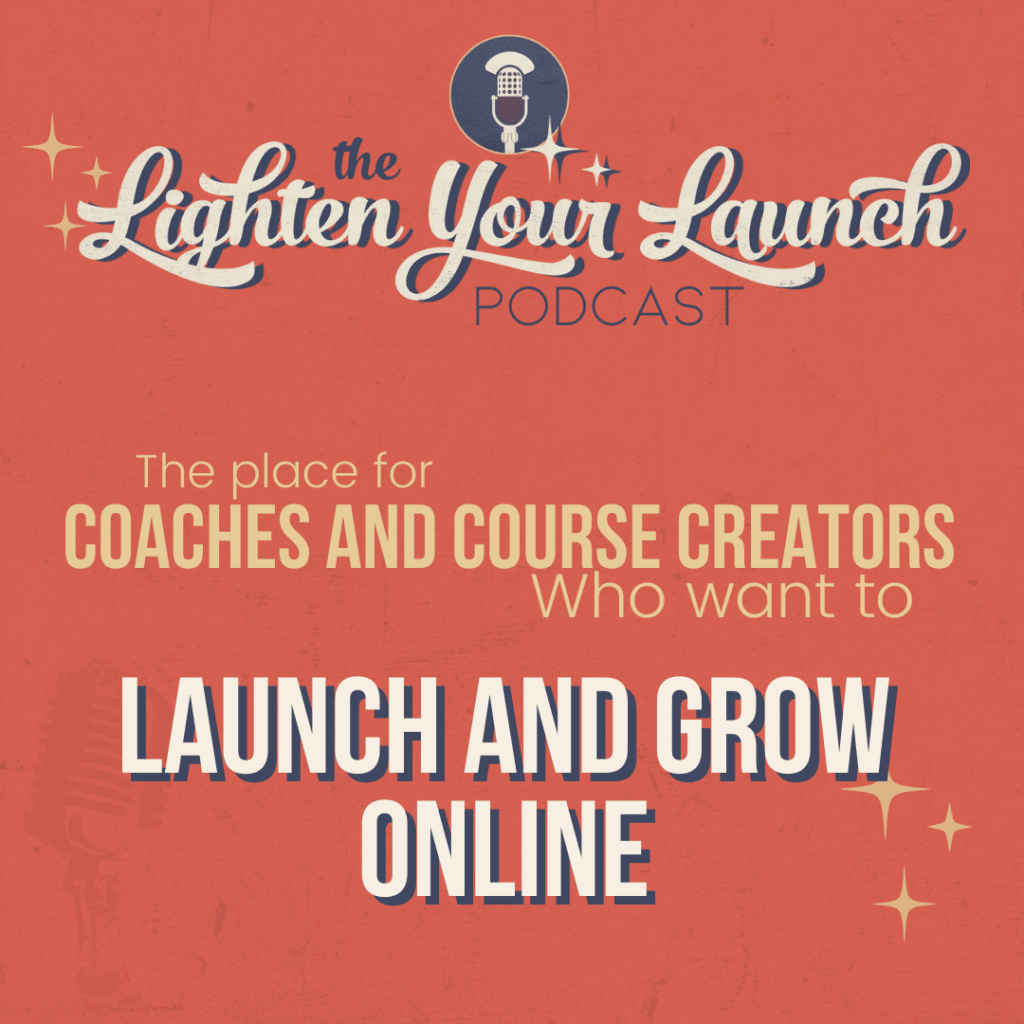
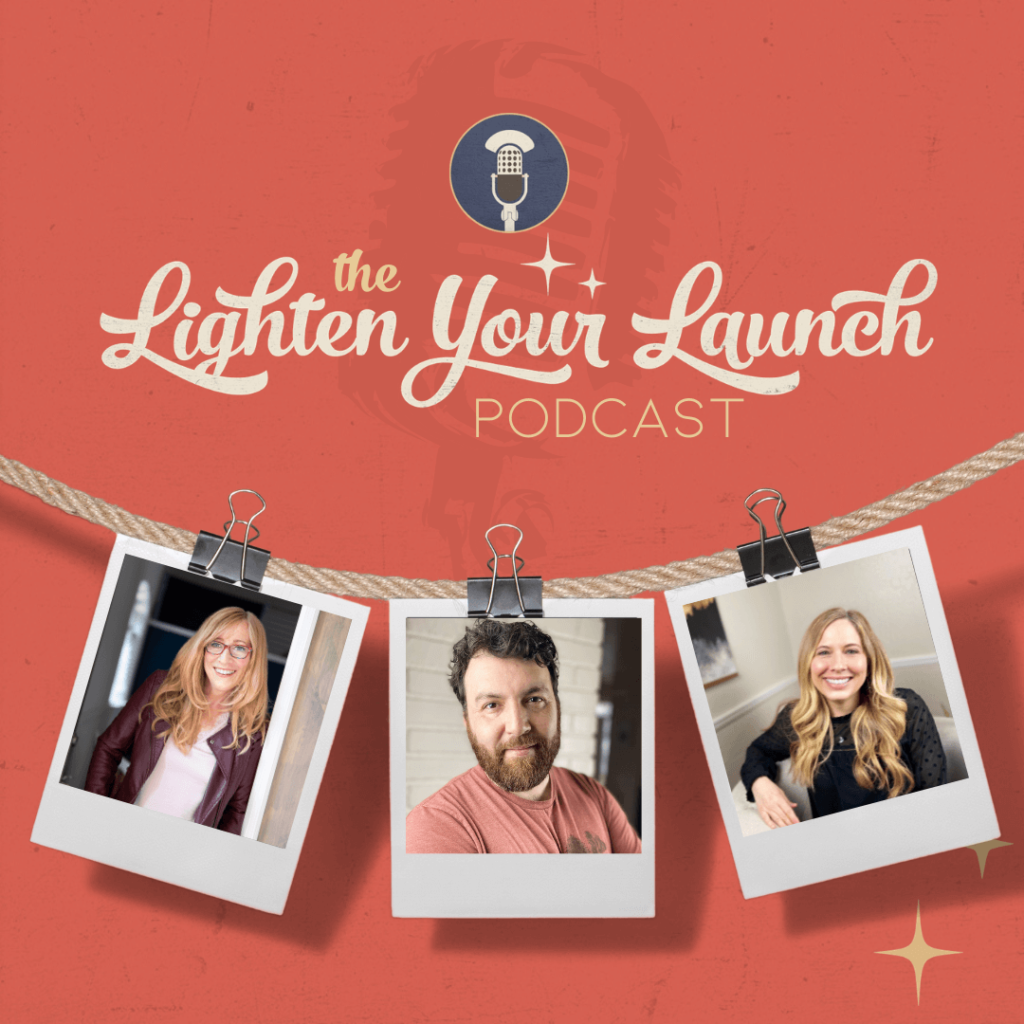


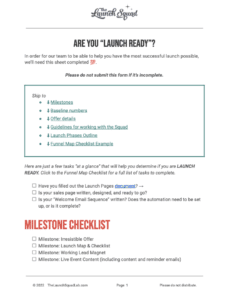
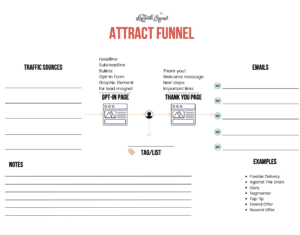
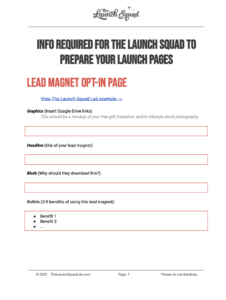
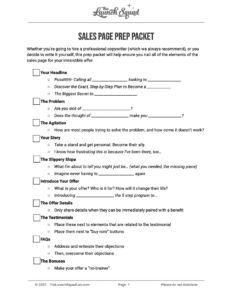
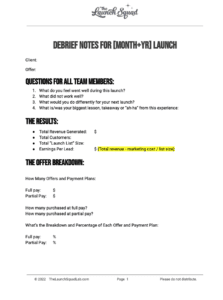
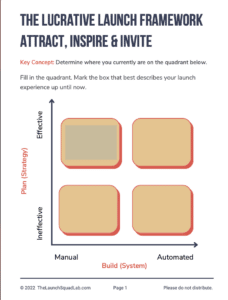
![Marketing Launch Calendar [TEMPLATE]](https://thelaunchsquadlab.com/wp-content/uploads/2023/05/Marketing-Launch-Calendar-TEMPLATE-300x260.png)
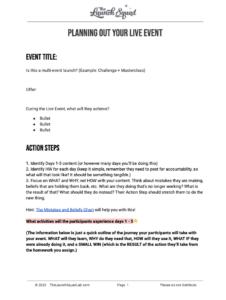
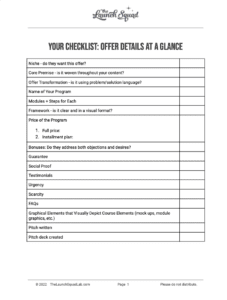
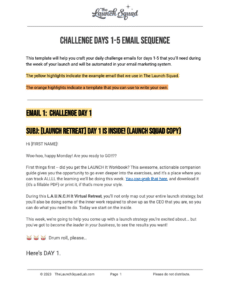
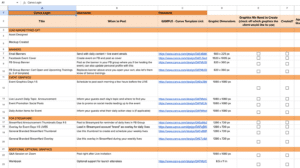
![[Updated] Email Templates for Launch](https://thelaunchsquadlab.com/wp-content/uploads/2023/05/Updated-Email-Templates-for-Launch-223x300.png)
![[REVISED] LS Pitch Script](https://thelaunchsquadlab.com/wp-content/uploads/2023/05/REVISED-LS-Pitch-Script-2023-226x300.png)

